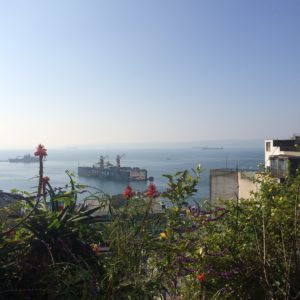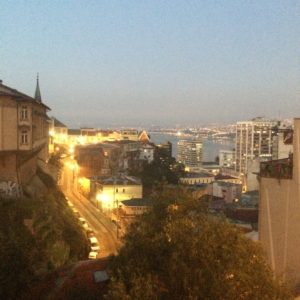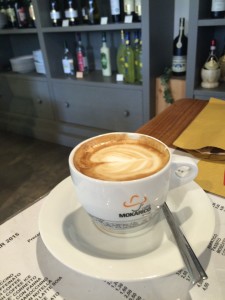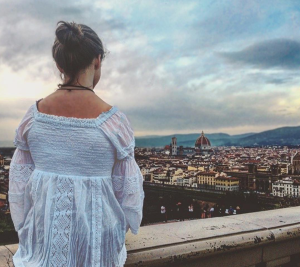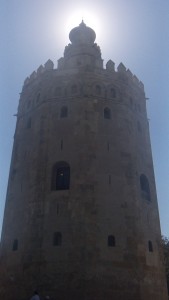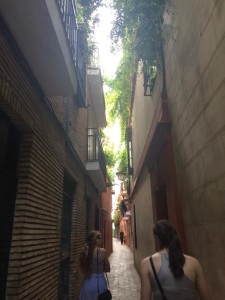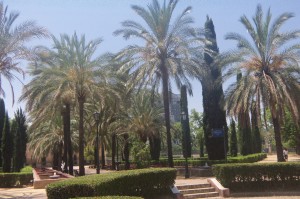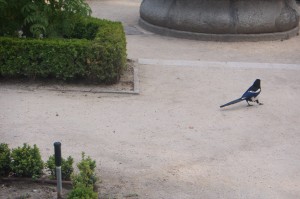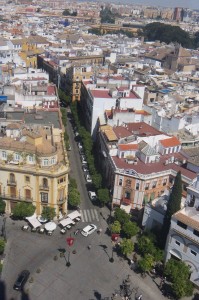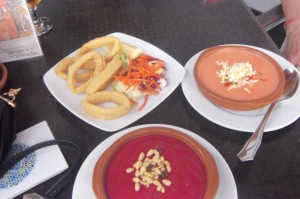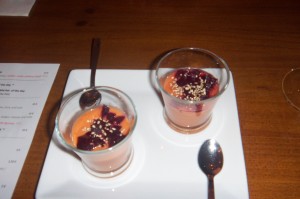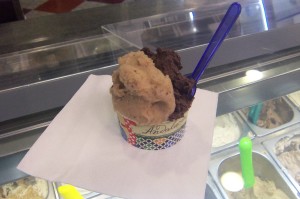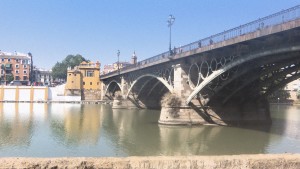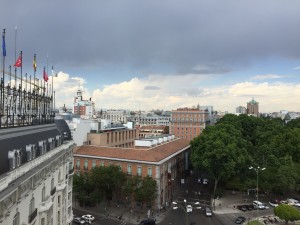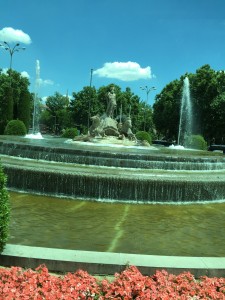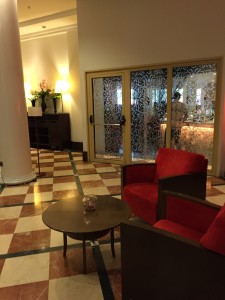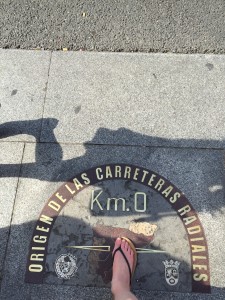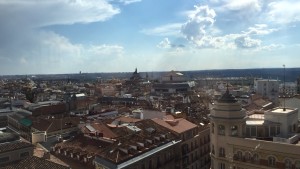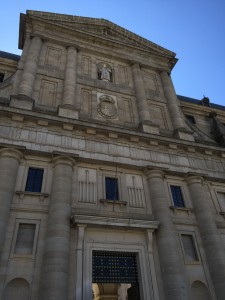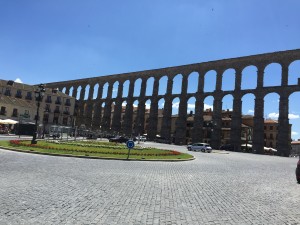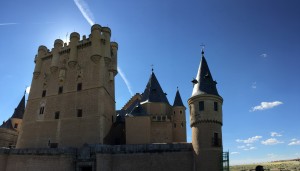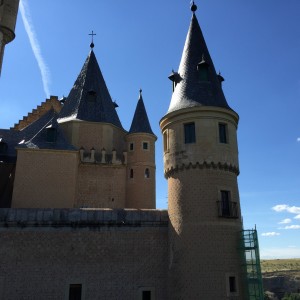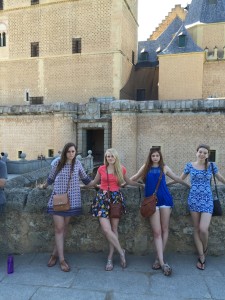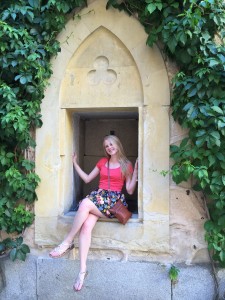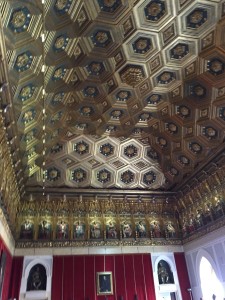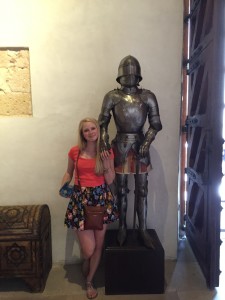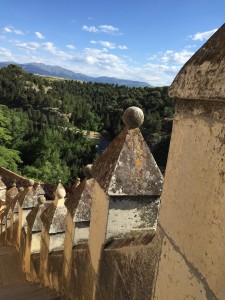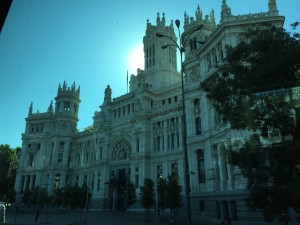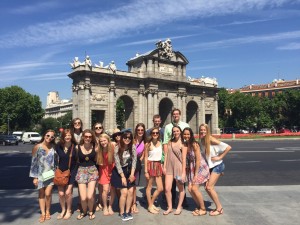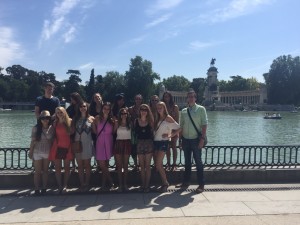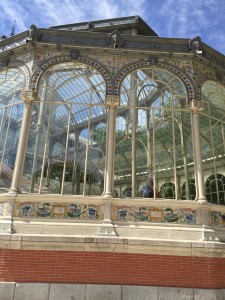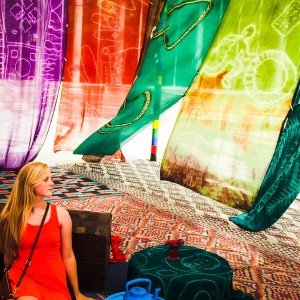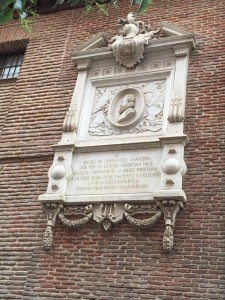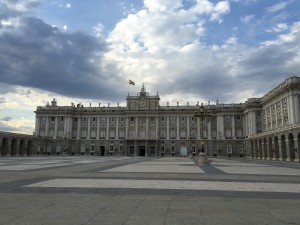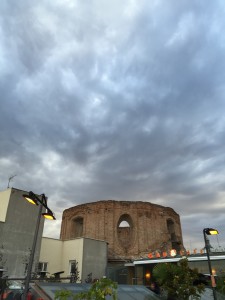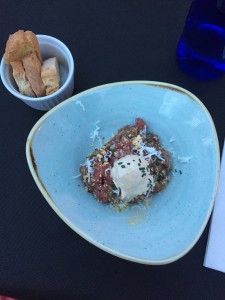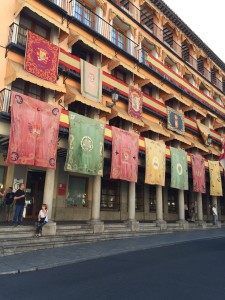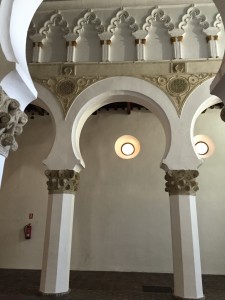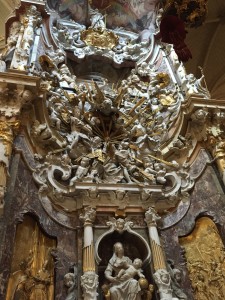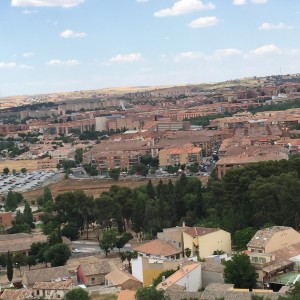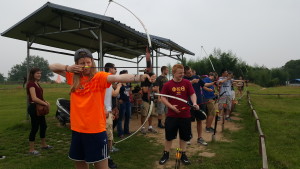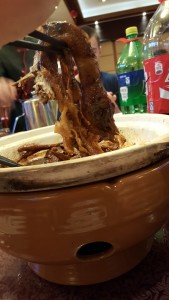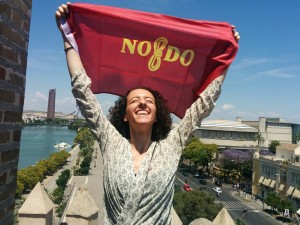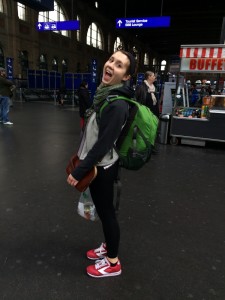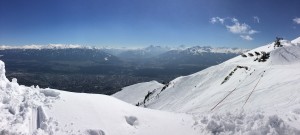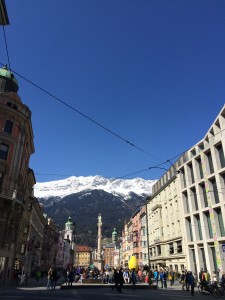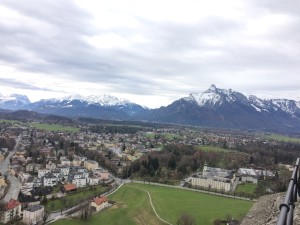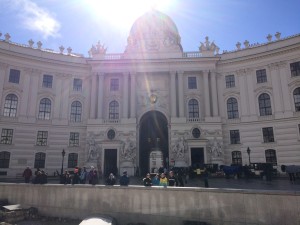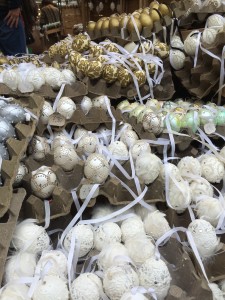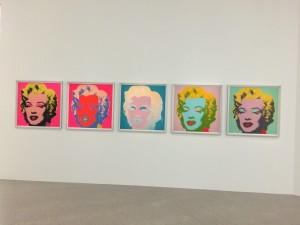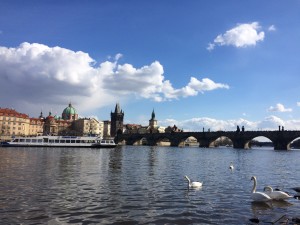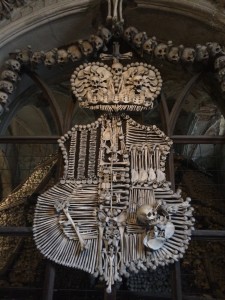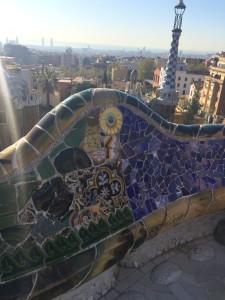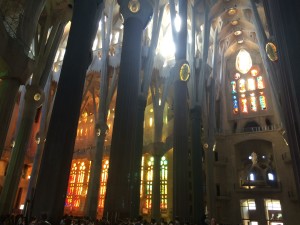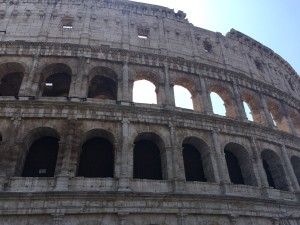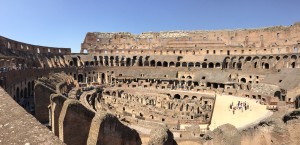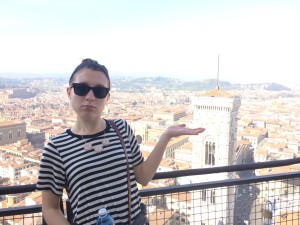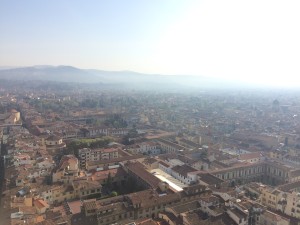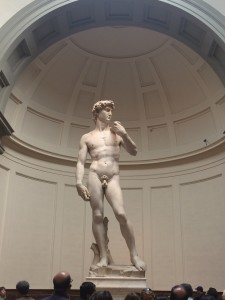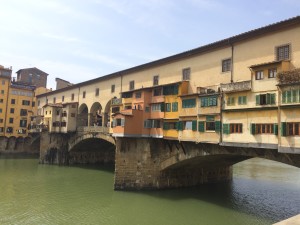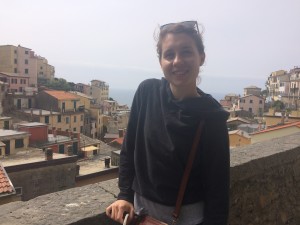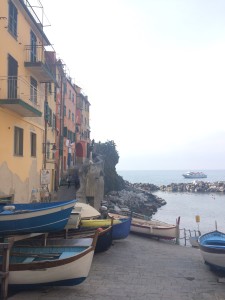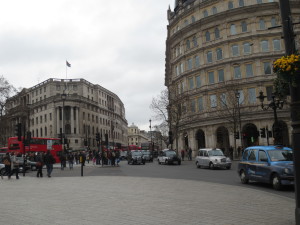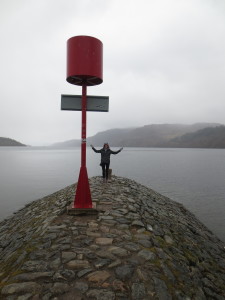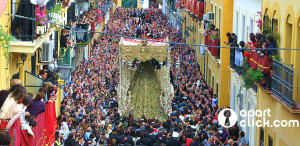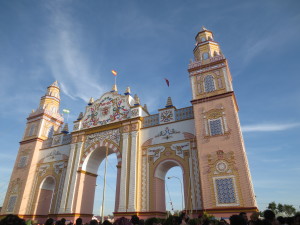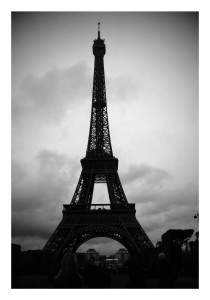Friday: First Exposures
I’ve learned that there’s always something to celebrate in Spain. Whether it is a citywide festival or one for a church, everyday there’s something new. Only a few hours after we arrived in Spain, we set off to Ronda Romántica, a festival celebrating the history of the city.
Around 8 o’clock on Friday night, tourists and locals alike began to line the streets in the small town, patiently awaiting the procession.
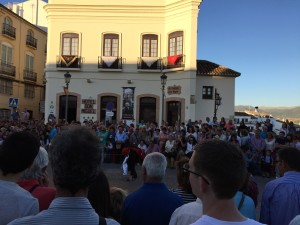
People gather around the sides of the Plaza de España to watch the procession
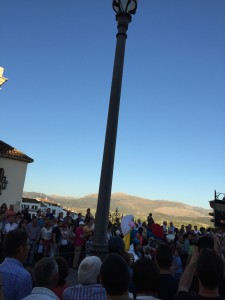
Smurfs in Spain?
The parade was meant to showcase Ronda’s history throughout the years, displaying the different attire worn in each era and acting out different sorts of scenes. But due to the heavy flow of people and relative shortness of the group, we decided that we would get to better know the city if we did so in one of its most important avenues that we could actually see—the food.
And so began the hunt for our first tapas experience. (Tapas are similar to small appetizers, and typically for dinner a person orders two or three.) There are an unbelievable amount of restaurants around the town. To try every restaurant on a side street for dinner, it would take at LEAST a week. With so many to choose from, we naturally had to walk around and see which would be the best pick. And unlike the US, everything in Ronda looks like art. The flowers on the terraces and the thatched roofs of buildings create something so picturesque for people like me who don’t live there, but something so normal for those who do. Sure, this is to be expected, but at the same time I can’t imagine ever getting tired of the scenery.
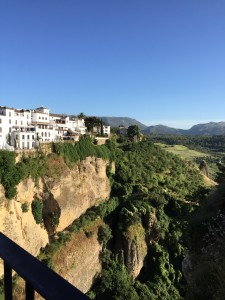
View of the opposite side of the cliff as seen from Puente Nuevo
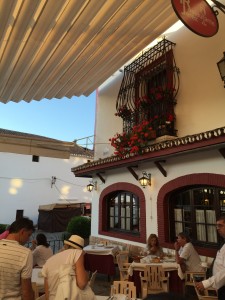
One of the many restaurants off of La Plaza de Toros, seen in the backround
After walking around for a half hour or so soaking everything in, we settled on a place on a side street off of the Plaza de España, where the parade had been held. Since all of the restaurants are in such close quarters, no one is really sure as to what the name was of the one that we went to, but one thing is certain—we are never going back. I can speak for all of us when I say that we were expecting a nice first tapas experience, but it turned into anything but that. Being that the majority of the group had only been in the country for a few hours, the language gap was still very real. While we were directing questions to our professor, Dr. Blue, about what each dish was, the waiter was barking at one of the students to tell him her order. It had been two minutes from the point that we sat down to when this happened. Once he got flustered enough, he let us alone for a few more minutes to look over the menu further. This was especially tricky for me because I have some pretty serious food allergies and didn’t want to have anything happen. On the bright side, it was one hell of a vocabulary lesson.
From tapas, to pasta, to pizza, tons of different things were ordered. Once they arrived, I think that everyone enjoyed themselves. I ordered ‘Arroz con leche’, which translates to ‘Rice with milk”. My allergies are to tree nuts and shellfish, so this seemed to be a safe bet. Initially, the waiter forgot it and was arguing with my professor, insisting that he was right. Once he realized that he forgot it he went back to place the order. Later on it came out with a questionable garnish on it. Was it an onion? Was it a string of white asparagus? Only taste buds could tell. Whenever this happens, I give a piece of the unknown substance to someone at the table to see what it is and if it’s allergy friendly. The lucky recipient this time was my professor, who then told me that it was a string of calamari, or squid for those who are unfamiliar. I passed it around the table after that so that it would go to waste, being that I couldn’t have it myself. Tapas: 1, Danielle: 0
Saturday: Viva la Fiesta
Prior to departure for Spain, our main faculty leader, Susana, told us to bring a long black skirt and a white shirt to match. The next morning after arrival, we were told to put them on (fret not, the three boys in the program were allowed to wear pants) and meet in the Plaza at 11. We had no idea what the occasion was or what they represented when we put them on, but as we walked from the Plaza to our unknown destination, we quickly found out why. Like the parade the day before, people were wearing clothing representing different time periods. Susana gave us cloth type scarves to wrap around our waists that were similar to theirs. Now, I wouldn’t say that we looked like Spaniards by any means, but we definitely fit in more than the rest of the foreigners. Our destination was at the intersection of a blocked off street and the patio courtyard in front of a church. There we met some more parade people, including some pirates and some horses that were also dressed for the occasion.

Townspeople dressed in clothing for the festival

Hanging out with the locals
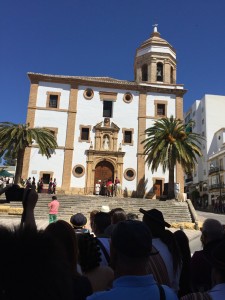
Play taking place on the church steps
IMG_2004
(Click for video)
Though we hadn’t been immersed in Spanish much at that point, the show was still cool to watch. I’m a fan of theatre in the United States, so it was interesting to see how they did it in another country.
After the show, we walked through an open market where sellers had set up shop. From meat and cheese to giant doughnuts to jewelry to clothes, they had it all. I tried some ‘queso de oveja’, or ‘sheep cheese’. Picture a mix between Asiago and Manchego to get the taste. It was FANTASTIC. (A side note: As I write this, I’m on the bus to Madrid and we just passed a cheese shop going through town…YES)
Other students tried chorizo, a sort of Spanish sausage, while some tried some desserts that can only be named by description.
Later that night, we went to the Plaza de Toros for a horse competition. The seats in the audience were filled nearly all the way up on the bottom ring at first, but later on when they opened up the top section the majority of people moved into the shade, including us. Our teacher told us that back when there were bullfights in the Plaza, the pricing of seats was based on closeness to the fight and whether it was shady or sunny in that part of the colosseum. The participants dressed up in traditional clothing and the competition began, with each person showing their routine one after one.

One of the competitors performing
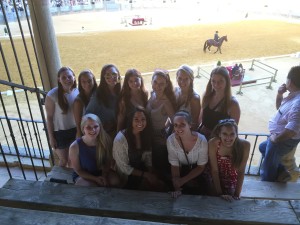
Handful of the PSU students at the show
Afterwards, we went out for tapas round two. This time, I ordered another popular item in Spain—jamón ibérico (ha-mohn ee-bear-ee-coh), or Iberian Ham. It’s comparable to prosciutto, but with a little more salt and a slightly different texture. In my time here I’ve learned that Spaniards LOVE ham and that it’s incorporated into the majority of their dishes (We actually just passed a museum solely dedicated to ham in Madrid—more on that later). Within a day, we’d gotten better at ordering in Spanish and speaking to the waiters in general, too. Progress!
Sunday: Siestas and Sacerdotes (Naps and Priests)
After a busy day Saturday, we had the following one free. Since most of the shops are closed on Sundays here, we decided to observe another staple of the Spanish culture—mass. The cool part about Ronda is that you can wander in any direction and eventually run into a church…so we met up around one o’clock in the afternoon and that’s exactly what we did. Upon arrival, it was beautiful. The entire building was a collection of fine details that made it into quite the work of art.
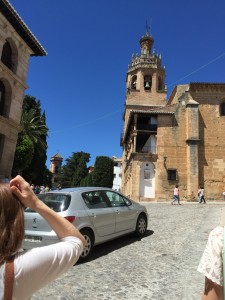
Church that we ventured to in the historic district of Ronda
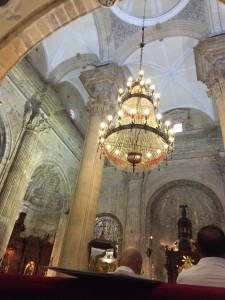
Beautiful church ceiling and chandelier
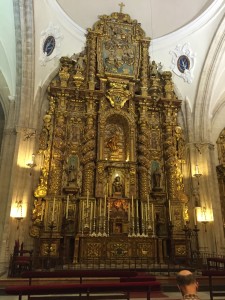
Sculptures and altars
Little did we know at the time that it was the first of many churches we’d be seeing throughout the trip. In any case, the mass followed the same general procedure as those that I’d been to at home. Aside from the fact that the group of people I went with had zero idea as to what the priest was saying, the main differences that we noted was that the congregation didn’t sing at all and that the mass was only a half hour long. I don’t go to mass as often as I did when I was younger anymore, but I do recall lots of singing and at least an hour per each service.
On Sundays, most stores are closed here. So with no work to do yet and plans to explore later, we chose to observe one of the most valued aspects of Spanish culture: SIESTA
Monday: Let the Classes Begin
Everyone knows that first day of school feeling. But instead of reencountering that familiar combination of excitement and anxiousness, I didn’t feel any way at all. I remember walking down Calle de la Bola (Pronounced cah-yay day la boh-la which is the nickname that the street received from wintertime activities…aka children rolling snowballs down its hill) thinking that I couldn’t possibly be in Spain and that I also couldn’t possibly be going to school. I guess one could say that I was in a denial of sorts, but not one of the negative variety.
Classes themselves were originally supposed to take place in the Spanish School for Foreigners (Escuela de Extrañjeros), but due to its far location from some of the students’ host families, Susana arranged for us to take classes in the Palacio de Congresos, which is a municipal building that overlooks the famous bridge. Who doesn’t love a room with a view?
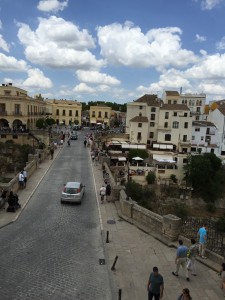
View from the terrace
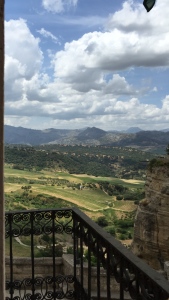
From the balcony to the valley
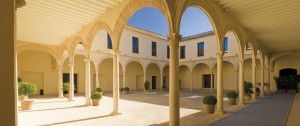
Inside of the first door. We have class upstairs in conference-type rooms
Each student in the program takes a combination of three classes depending on their level. Having just completed my freshman year at Penn State, I am enrolled in SPAN 200, SPAN 253W, and SPAN 410. The first is my required next level grammar, the second is an analysis of Spanish literature, and the last is advanced conversation. My grammar class is taught by two local professors who switch on and off every week whereas my other two are faculty from Penn State. We have school from 9:00-2:30 Monday through Friday, and each class is an hour and forty minutes long.
We took a field trip during the first period to observe one of Ronda’s many festivals called the Virgen de Rocío at the same church that we’d gone to mass at the day prior. The festival represents a grand trip taken by foot through Andalusia, the province of Spain that Ronda is in, to Rome.

Festival decor
The Lechugita Experience
After classes and all other things that the day entailed, we decided to reward ourselves with dinner. Two of the students had received a recommendation from their host mom to go to a place on one of the side streets that branched from Calle de la Bola, so we decided to try it out. Most tapas are cheap, but these put the others to shame—they were only 80 cents each! Needless to say, I was a fan. I tried queso with tomato, Spanish meatballs, and tortilla Española (the same dish that I had on the first day at my host house) which were all very good. For ten people, our total check was only 39€, which translates to about $43 with the current exchange rate.
In the weeks since, we’ve discovered that the name of the bar is Lechugita, which means ‘little lettuce’. One of their most successful items on the menu is a section of a head of lettuce topped with olive oil and salt, hence the name. However, at the time we didn’t realize what the place’s name was, and on arrival home when our host mom asked where we’d went, there was a bit of confusion. We had heard about Lechugita before, but didn’t think that we’d ever come across it. The sign on the front of the building is in painted tile and can be easily misconstrued as a painting instead of a name. My roommate and I had thought that lechugita was a popular tapa served at a bunch of different places, so when we told our host mom what we’d eaten, she asked how Lechugita was, to which we responded that we didn’t go and only saw people try the food itself. We didn’t get why she kept insisting that we went to the actual place, but accredited it to the language gap until a week or so later when we learned that the only lechugita served in Ronda is at Lechugita…oops. Rookie mistake.

Tortilla de patatas (left) and albóndigas (meatballs) covered by bread (right)
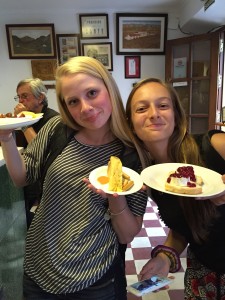
WE LOVE TAPAS
Tuesday: Exploration Galore
After the second day of classes, we ventured into a few of the oldest parts of Ronda. First, we visited the ‘Museo Municipal’, or Municipal Museum. There we saw different style patios designed by the Arabic, which included the horseshoe arch that will appear more later on. The museum explained the history of Ronda in itself, from the very first inhabitants to more recent structures such as Puente Nuevo, the new bridge.

Entrance to the museum. The concrete structure below the sign used to be used to mount horses due to the relative shortness of the riders in years past
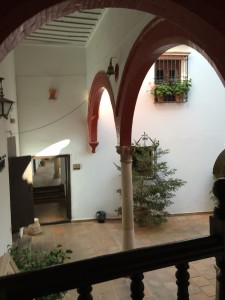
Arabic arches
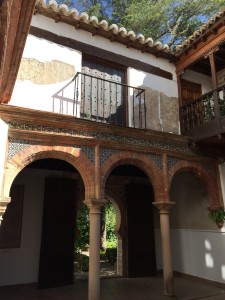
Another angle
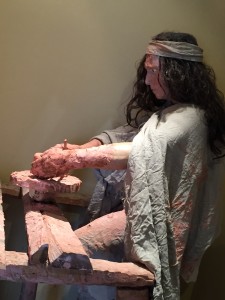
An interesting representation of older life in Ronda
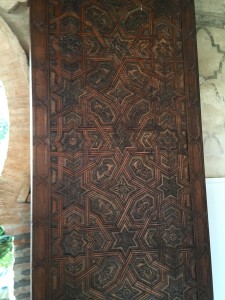
Hand carved door separating one of the patios from outside next to a horseshoe arch
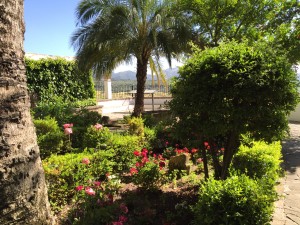
The secret garden of the Museo
Our next stop was the Baños Arabes, or Arabian Bathrooms. Here we walked through an 800 year old structure that was rediscovered in the 1900’s after being covered by water for centuries. People would bathe themselves twice a day in one of the three rooms. There was a hot, lukewarm, and cold room to choose from, depending on the desired temperature of water. For as old as it was, it was definitely cool to see how advanced the technology was for the time that it was created and used. As can be seen in nearly every entrance, the architects utilized the horseshoe arch.
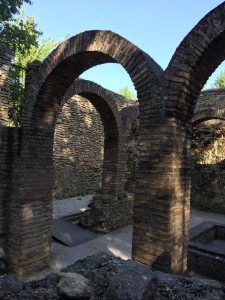
Outside of the main rooms of Los Baños Arabes
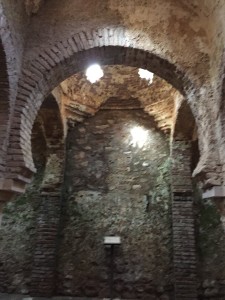
Interior rooms with holes in the ceiling used to let steam escape
Later on, we walked through the Historic District of Ronda and visited Puente Viejo, or the old bridge. Considering that the new bridge, Puente Nuevo, was built just before 1800, Puente Viejo is clearly very viejo indeed.
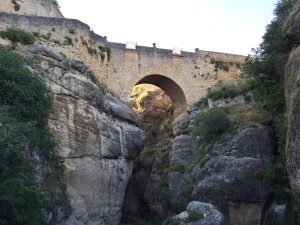
El Puente Viejo
Our walk led us to Los Muralles, (Moo-rye-yeys) or The Walls. These were built by the Arabic for the purpose of guarding the city and acting as a watch for any possible invaders, but today they provide a beautiful view of the outskirts of the city.
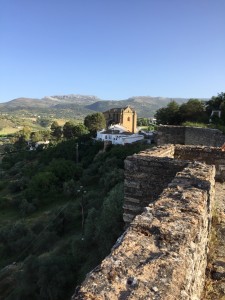
View from the top of Los Murralles

Looking out into the valley
Wednesday: The City’s Trademarks
Having visited Puente Viejo the day prior, it was only fitting to visit Puente Nuevo the following day. Though we had been walking across it to get to school every day, we hadn’t yet gone inside of it or read about how it came to be the way that it currently is. For those who paused a second thinking that they’d read the statement incorrectly, yes. We went inside of the bridge. The interior room used to be a prison in Ronda, and not too long ago. Our professor, Susana, said that when she was younger, convicts were still held there. I remember laughing at the thought that a bridge over 200 years old was considered to be new, but in the grand scheme of thinking about how old Europe actually is it makes much more sense.
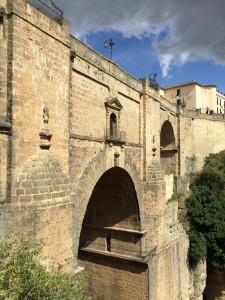
Sideways view of Puente Nuevo. Make note of the small window in the center–this was so that prisoners could have some light and a bit of a view
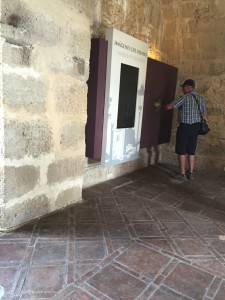
Inside of the bridge with a tourist
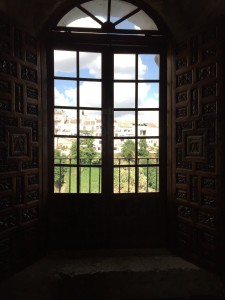
View from the prisoner’s window–not too shabby
Following our visit to the bridge, we returned to yet another well-known landmark that we’d seen: La Plaza de Toros. This time wasn’t for a show, but rather for a tour. We walked through different sections, learning about the creation of the Plaza, different outfits that bullfighters were supposed to wear. (Picture and explanation) and what each fight was like. Every bullfight consisted of three bullfighters and six bulls. The bullfighters performed in order from the least to most skilled with the first bulls and then repeated the process with the second round of bulls. To simplify, each bullfighter fought one bull at a time and two bulls total.
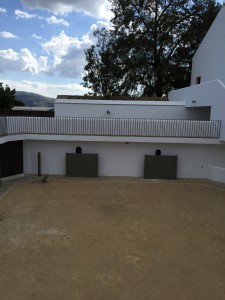
Bullpen for practice
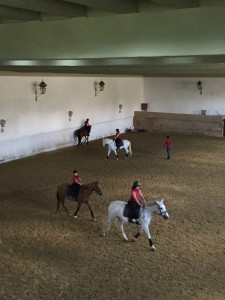
Students learning to ride horses inside of one of the Plaza’s rooms
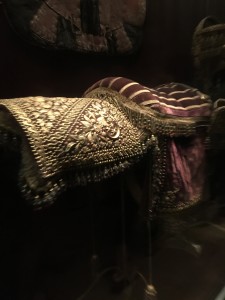
Saddle for competitive horse performances
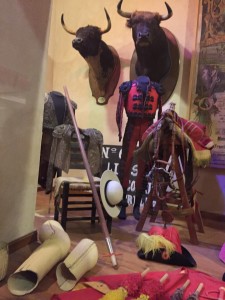
Typical dress and instruments used during the fights
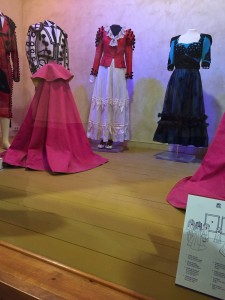
Typical ladies’ attire
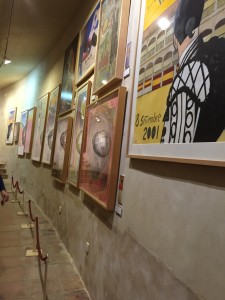
Hall of bullfighting advertisements for Ronda’s annual bullfight

Inside the stadium
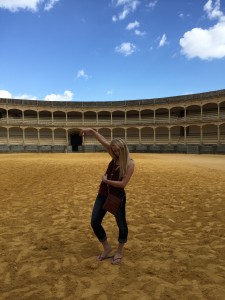
Am I a bullfighter yet?
After the general tour, we had the opportunity to see the Plaza’s library. At first, none of the students realized how big of a deal it was, but Susana later told us that the only other person they’d received that day had been the General of the Spanish Army. The library had books as old as the 14th century kept in pristine condition inside the many glass-covered bookshelves that lined the room. For someone who loves books as much as I do, it was incredible.
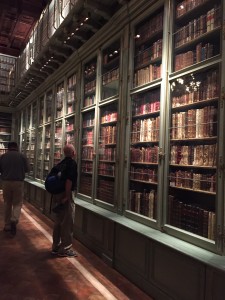
Shelves on shelves on shelves
Thursday: Underground Caverns and Lots of Steps
Towards the end of the week we visited La Mina Secreta, or Secret Mine. It was constructed in the 14th century as a military structure and goes 80 m (about 264 feet) descending from the city to the river. We tried to count steps, but lost track about halfway. The caverns were cool to look at but easy to slip on, so we constantly held on to the sides. While all of the rooms were cool to look at, the final few provided the best experience. One room played with sound: two people would stand in diagonally opposite corners of the room, facing the junction of the two walls. One of them would whisper a phrase so that the general audience couldn’t hear it, but because of the structure of the room the whisper carried to the person in the opposite corner. The room was also structured so that if a person stood in the absolute center and began talking aloud, he or she couldn’t hear any other voice but his or her own. Other visitors saw our group doing this and later joined in after their initial confusion.
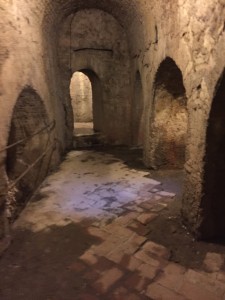
One of the many rooms of La Mina
Once we left that room, we went down a few more steps and stood on a platform that was even with the river. I had thought that I’d seen all of the views that there were to see in Ronda in our intensive first few days, but boy was I wrong. It was absolutely beautiful.
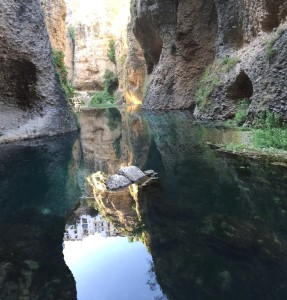
View from the river’s level
Friday: Dining in Old Ronda
To celebrate the completion of our first week of classes and activities, we decided to treat ourselves to dinner in the Historic District. Like we had been doing during the week, we decided to walk until we stumbled upon a menu that we liked. This particular place had a gorgeous view of the mountains and sunset, complete with a guitarist in the park serenading the customers.
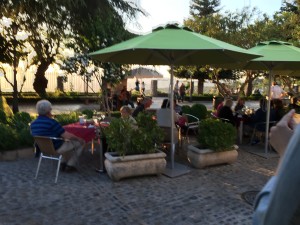
Restaurant scenery with the view in the far back
This was one of the many moments on the trip where I’d stop and look around, not really believing where I was. I still do that sometimes. For example, now, typing this, staring out my bedroom window on the second to last Monday in the program (I’ve written this over the course of a few weeks due to a heavy workload, tons of fieldtrips, and generally enjoying this city of mine) I have a hard time believing that I am where I am.
When you come to Spain, there is no such thing as getting used to the water—you’re thrown right into it. And while sometimes it’s crazy to stop and think about where you are and what you’re doing, every moment, good and bad, it’s so worth it. Stay tuned for a wrap on the second Saturday’s trip to Sevilla.




